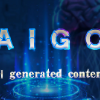As ChatGPT goes viral, generative AI (AIGC, a.k.a AI-generated content) has made headlines everywhere because of its ability to analyze and create text, images, and beyond. With such overwhelming media coverage, it is almost impossible for us to miss the opportunity to glimpse AIGC from a certain angle. In the era of AI transitioning from pure analysis to creation, it is worth noting that ChatGPT, with its most recent language model GPT-4, is just a tool out of numerous AIGC tasks. Impressed by the capability of the ChatGPT, many people are wondering about its limits: can GPT-5 (or other future GPT variants) help ChatGPT unify all AIGC tasks for diversified content creation? Toward answering this question, a comprehensive review of existing AIGC tasks is needed. As such, our work comes to fill this gap promptly by offering a first look at AIGC, ranging from its techniques to applications. Modern generative AI relies on various technical foundations, ranging from model architecture and self-supervised pretraining to generative modeling methods (like GAN and diffusion models). After introducing the fundamental techniques, this work focuses on the technological development of various AIGC tasks based on their output type, including text, images, videos, 3D content, etc., which depicts the full potential of ChatGPT's future. Moreover, we summarize their significant applications in some mainstream industries, such as education and creativity content. Finally, we discuss the challenges currently faced and present an outlook on how generative AI might evolve in the near future.
翻译:随着ChatGPT的广泛传播,生成式人工智能(AIGC,即AI生成内容)因其分析和创造文本、图像和其他领域的能力而在各大媒体上屡见不鲜。在这样压倒性的媒体报道下,我们几乎不可能错过从某个角度了解AIGC的机会。在AI从纯粹的分析走向创造的时代,值得注意的是,使用最新语言模型GPT-4的ChatGPT仅仅是众多AIGC任务中的一个工具。许多人对ChatGPT的能力印象深刻,但也有疑虑:GPT-5(或其他未来的GPT变体)能否帮助ChatGPT统一所有AIGC任务,实现多样化的内容创作?为回答这个问题,需要对现有的AIGC任务进行全面回顾。因此,本文应运而生,首次全面介绍了AIGC技术和应用。现代生成式人工智能依赖于各种技术基础,包括模型架构和自监督预训练以及生成建模方法(如GAN和扩散模型)。在介绍了基本技术之后,本文重点关注基于输出类型的各种AIGC任务的技术发展,包括文本、图像、视频、3D内容等,展示了ChatGPT未来的全部潜力。此外,我们总结了它们在一些主流行业中的重要应用,比如教育和创意内容。最后,我们讨论了目前面临的挑战,并展望了生成式人工智能在不久的将来可能会如何发展。





